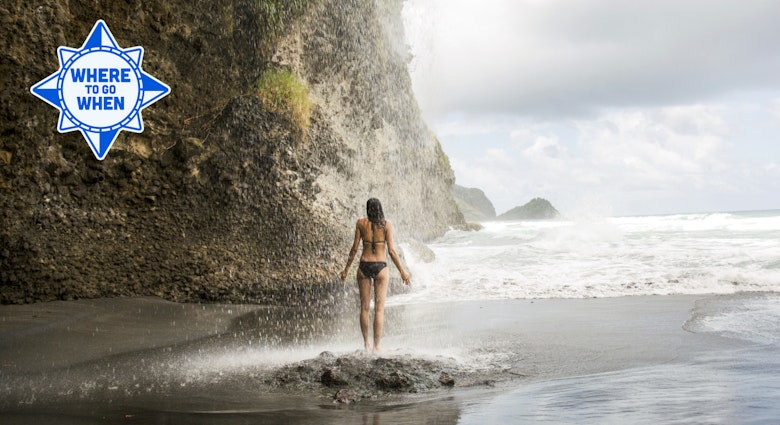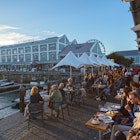
8 best places to visit in Botswana



See incredible wildlife in these top places to visit in Botswana © Tiago_Fernandez/Getty Images/iStockphoto
Combining mind-blowing wildlife, cinematic landscapes, and plenty of knowledgeable guides, Botswana always has something thrilling to discover.
Home to some of Africa’s most stunning – and budget-busting – lodges and tented camps, Botswana leads the way in low-volume, high-value safari tourism. Vast expanses of this dazzlingly diverse country are protected spaces, allowing a staggering array of wildlife to roam freely. So whether you join a mobile safari or self-drive and stay at a state-owned campsite, you won’t have to splash too much cash to get close to wild nature.
Here’s a rundown of the best places to visit in Botswana.

1. Okavango Delta
Best for luxurious wildlife watching
- placement: fullWidth
- path: articles/in-content-top
- possible size: [970, 250], [970, 90], [728, 90], [300, 250], [320, 50], [1, 1],
- targeting:
{ "url": "best-places-to-visit-in-botswana", "destination": "Botswana", "continent": "Africa", "country": "Botswana" }
Dubbed the "Jewel of the Kalahari", the Okavango Delta is a highlight of any Africa trip. Heavy rains in the Angolan highlands swell the Okavango River, which spills across the desert, fanning out into a shimmering maze of channels, lagoons, and islands. Covering around 20,000 sq km (7700 sq miles), it is the world’s largest inland delta. The lodges here follow Botswana’s exclusive, high-end model, but you’ll be virtually tripping over wildlife, including the Big Five. You might even catch lions swimming between islands, alongside endangered African wild dogs and more than 500 species of birds.
You can explore by 4WD and on foot, but the best way to get up close to the delta is by mokoro, a traditional canoe that sits low on the shallow waterways. A Botswanan gondolier will steer you through the rustling reeds to spy on dainty jacana birds hopping between lily pads, leaping red lechwe (the delta’s aquatic antelope), and elephants taking a dip.
Planning tip: Don’t expect a watery wonderland on arrival in Maun. You must travel at least an hour north for mokoro rides, and three hours to Moremi Game Reserve or Khwai for game-viewing, and the top wilderness encounters often require a short flight to a luxury lodge.

2. Moremi Game Reserve
Best for a self-drive safari
Covering around 4000 sq km (1500 sq miles), the Moremi Game Reserve – the oldest protected area of the Okavango Delta – might be small by Botswana’s standards, but what it lacks in size, it makes up for with the density and diversity of its wildlife. It’s also the most accessible corner of the delta for self-drivers. Watch feasting lions, leopards lolling in trees and wild dogs hunting in relay – it’s the stuff of safari dreams – and that’s not forgetting the bounteous birdlife and staggeringly beautiful landscapes, from mopane woodland to ilala palms, dry savannah to seasonal floodplains, and permanent reed-fringed lagoons.
Considered the crème de la crème of safari destinations, Chief’s Island is home to herds of red lechwe, zebra, wildebeest, buffalo, and big cats galore, as well as troops of baboons and vervet monkeys, with rivers stuffed with colossal crocodiles and harrumphing hippos. Moremi Game Reserve has no shortage of sensational luxury lodges to choose from, but it also has community-run campsites if you’d rather an elephant snuffling around your tent wake you than a butler.
Planning tip: Moremi's luxury lodges have the perks of year-round boating and varied habitat for guided game drives, but public park policies mean they can't operate night drives or do walking safaris like the private concessions of the Okavango Delta.

3. Makgadikgadi Salt Pans
Best place for otherworldly thrills
- placement: fullWidth
- path: articles/in-content-middle
- possible size: [970, 250], [970, 90], [728, 90], [300, 250], [320, 50], [1, 1],
- targeting:
{ "url": "best-places-to-visit-in-botswana", "destination": "Botswana", "continent": "Africa", "country": "Botswana" }
The crusty white expanse of the Makgadikgadi Pans is all that remains of a long-vanished lake. The world’s largest network of salt pans appears devoid of vegetation, save for isolated clusters of majestic baobab trees, but in the dry season (April to September) they possess a stark, surreal beauty. You can horseback ride and quad bike over the lunar-like landscape, and with zero light pollution, a sleep-out on the pans to watch the celestial light show is a must.
Wildlife may seem scarce, but the Boteti River to the west and the Makgadikgadi National Park offer more traditional game viewing. During and after the rains, the pans attract dazzles of zebra and herds of wildebeest during the annual migration, swiftly followed by lion, cheetah, and hyena. Sua Pan in the east near Nata is home to huge numbers of flamingos. To hang out with a habituated gang of meerkats, you’ll need to be guided to the golden grassland outskirts of the pans with a lodge guide.
Chapman’s Baobab – the arboreal beacon of the pans, thought to have been around 5000 years old with a circumference of 25m (82ft) – is no longer standing, but you can marvel at Baines’ Baobabs in neighboring Nxai Pan National Park.

4. Central Kalahari Game Reserve
Best for getting off the beaten track
Where the delta ends, the desert takes over. The Central Kalahari Game Reserve is Africa’s second-largest reserve (after Selous in Tanzania), and as its name suggests, it’s smack bang in the center of the Kalahari Desert. Don’t expect Sossusvlei-style dunes – the striking landscape is all glittering salt pans, fossilized river valleys and semi-arid grassland. It’s known for its desert-adapted species, including the legendary Kalahari black-maned lion, elephants and enormous herds of antelope. As one of the world’s most sparsely populated regions, you’re unlikely to bump into anyone else on a game drive.
It’s also the former ancestral home of the indigenous San people, hunter-gatherers with a profound connection to their land and its wildlife, who still practice their ancient traditions in neighboring private reserves.
Planning tip: You need time, grit, patience and a 4WD to scour the vast Central Kalahari Game Reserve. Unless you fly into a luxury lodge, it's not worth rushing it. The quickest way into the reserve is to camp at Deception Pan and enter via Rakops, but it's still best to cater for three nights and two full days.

5. Kgalagadi Transfrontier Park
Best for desert adventurers
Split between Botswana and South Africa, the remote Kgalagadi Transfrontier Park is a vast desert wilderness, a harsh but beautiful landscape where the dry riverbeds of the Nossob and Auob are flanked by rolling red dunes, picture-perfect at golden hour. You won’t find water-dependent hippos, elephants, buffalo, or zebra here, but you’ll be rewarded with sightings of desert-adapted antelopes, such as the stately gemsbok, and you have a good chance of big cat sightings, including lions, leopards, and cheetah.
Look out for smaller carnivores, too: perhaps a shy brown hyena, big-eared bat-eared foxes, or a wiry Cape fox. You can drive for hours without seeing a thing, which makes it all the more special when you do. For intrepid travelers, the Botswana side has some rudimentary campsites where there’ll be nothing but a thin wall of canvas between you and the resident predators. The South African portion has more accommodation options.

6. Chobe National Park
Best for budget-friendly safaris
- placement: native
- path: articles/in-content-native
- possible size: [f, l],
- targeting:
{ "url": "best-places-to-visit-in-botswana", "destination": "Botswana", "continent": "Africa", "country": "Botswana" }
Botswana’s first national park and now its second largest, Chobe is one of Africa’s most spectacular wildlife-watching areas with several distinct ecosystems. Arguably, it’s home to more elephants than anywhere else on the continent, as well as a host of easy-to-spot big cats, buffalo, giraffe and zebra, making it perfect for first-time safari-goers. Chobe’s northeastern corner and its namesake river are easily accessed by road from Kasane, making it more wallet-friendly – and much busier – than some of Botswana's more remote regions. A jumping-off point for Victoria Falls, Kasane has accommodations to suit all budgets, along with gas stations and grocery stores if you need to stock up.
It’s also the place to organize a 4WD safari along the river and its floodplains, or an unmissable sunset cruise, where gruff-looking buffalo, loping giraffes and enormous elephants flock to the river to drink. To get off the beaten track, head southwest, where the long-dry Savuti Channel – the stomping ground of large lion prides – is water-filled again and attracting more and more wildlife.
Planning tip: Because the wilderness is so accessible here, Kasane can get busy. To avoid the crowds, you can also comfortably base yourself beyond the park boundaries further afield in Lesoma Valley or Ngoma. The latter, at the western end of Chobe National Park, sees fewer tourists but is no less overflowing with wildlife (although you may have a cow or two wandering into view in this more rural setting). Otherwise, escape by boarding a houseboat and floating along the Chobe River.

7. Khama Rhino Sanctuary
Best for seeing the Big Five
Khama Rhino Sanctuary is home to several highly endangered black and white rhinoceros (and more wildlife besides) and is the best place in Botswana to get a close glimpse of these magnificent creatures. A great year-round destination, the sanctuary is also home to wildebeest, impalas, ostriches, brown hyenas, leopards and more than 230 bird species. The best time for spotting the rhinos is late afternoon or early morning at Malema's Pan, Serwe Pan and the water hole at the bird hide. Self-guided drives are possible to explore at your own pace but to guarantee a rhino sighting, go with a guide on a game drive, walking safari, or a rhino-tracking excursion.

8. Tuli Block
Best for mountain biking
An adventure-packed oasis sandwiched between Zimbabwe and South Africa, the Northern Tuli Game Reserve – which includes the illustrious Mashatu Game Reserve – is the star of the Tuli Block. Think towering hills popping out of the scrubland, epic sunset views alongside adorable elephant shrews, and ancient baobab trees. This wilderness is also steeped in history, adorned with remnants of ancient empires and scattered Stone Age treasures.
With guided walking safaris, horseback rides, and mountain biking adventures, it’s a playground for active souls. Whizzing along ancient footpaths by mountain bike on a cycling safari, you’ll pedal past giraffes and eland herds. The relatively flat terrain is forgiving, and routes trace paths trampled by herds of elephants for thousands of years, resulting in a single track that is smoother and more free-flowing than any artificial equivalent.
The legendary Horizon Horseback riding safaris also come highly rated but are for serious equestrians only with advanced intermediate riding experience. Every rider will take a short riding test to ensure competence to independently control a horse at all paces before the safari departs.
Planning tip: Wildlife in this area is not seasonal as with other areas in Botswana, so there is terrific game-viewing throughout the year.
- placement: fullWidth
- path: articles/bottom
- possible size: [970, 250], [970, 90], [728, 90], [300, 250], [320, 50], [1, 1],
- targeting:
{ "url": "best-places-to-visit-in-botswana", "destination": "Botswana", "continent": "Africa", "country": "Botswana" }
Explore related stories








 National ParksAll you need to know about African elephants – and where to spot them in the wild
National ParksAll you need to know about African elephants – and where to spot them in the wildApr 25, 2024 • 6 min read

